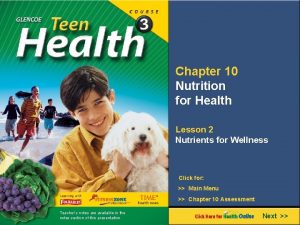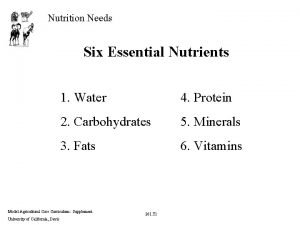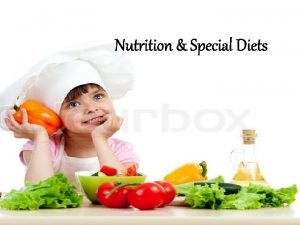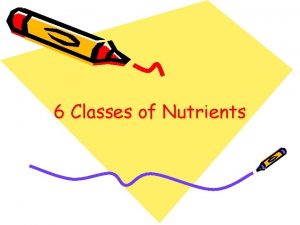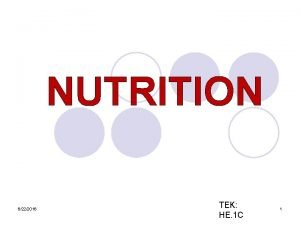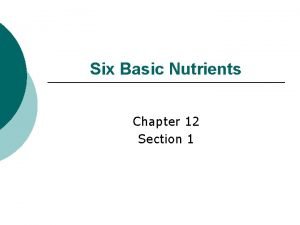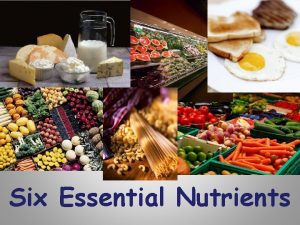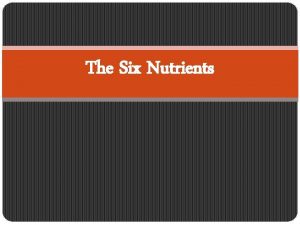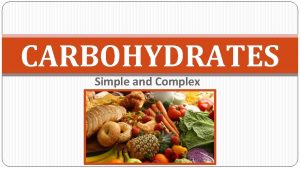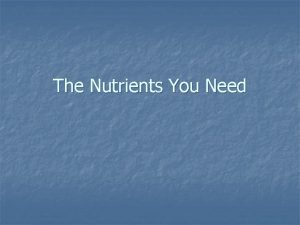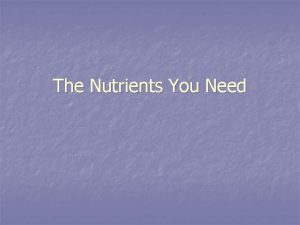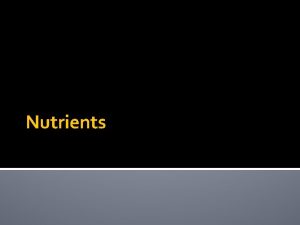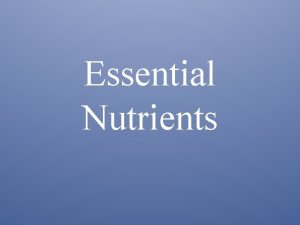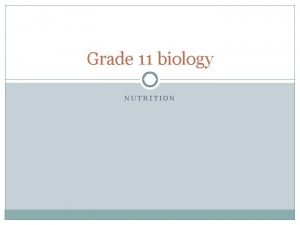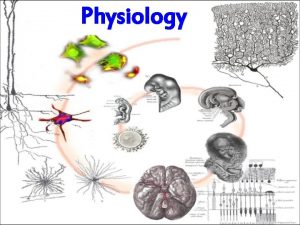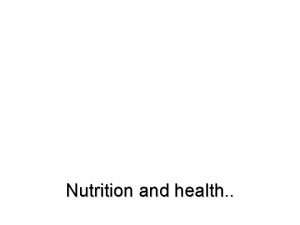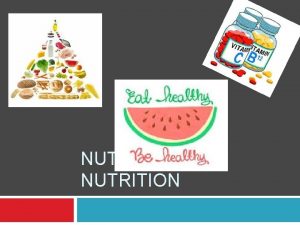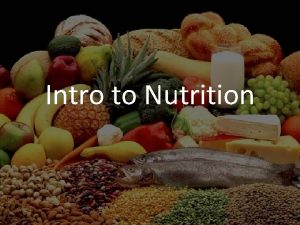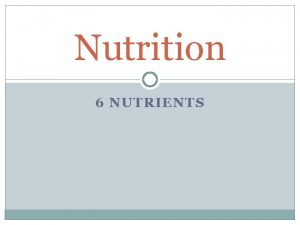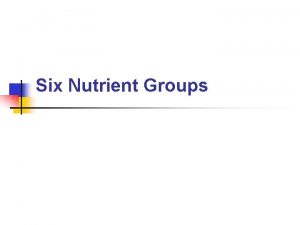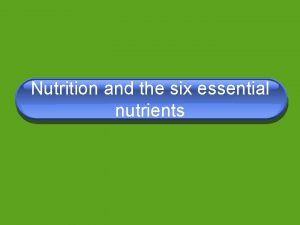the SIX nutrients What is nutrition Nutrition is





















- Slides: 21

the SIX nutrients

What is nutrition? ØNutrition is a process in which your body uses the food that you eat.

What is a nutrient? • Nutrients are components of food that provide nourishment and help our bodies function. • The body uses food as fuel for: • Energy • Growing Cells • Repairing Cells • Managing the body’s systems (circulatory, digestive, skeletal, muscular, etc. )

The Six Primary Nutrients Nutrition 6 Basic Nutrients Proteins Carbohydrates Fats Vitamins Minerals Water

Different people, different needs Ø The amount of a particular nutrient a person needs may be affected by their: • 1. Age • 2. Gender • 3. Activity Level (athlete vs. couch potato) • 4. Health Conditions (ex. Diabetes) • 5. State of Nutrition (are you already missing nutrients? )

Protein Ø Protein is used to make and repair the body’s cells (ex. muscle & organ cells)

Complete vs Incomplete Proteins Complete proteins contain adequate amounts of all nine essential amino acids. Incomplete proteins have insufficient levels of one or more of these amino acids. Type Sources Complete Proteins Meat, Poultry, Fish, Cheese, Eggs, Yogurt, Milk, Soy Incomplete Proteins Wheat, Barley, Beans, Lentils, Veggies

Fats Ø Fats are substances that build brain cells, help absorb certain vitamins, and insulate our bodies. They provide more calories per gram than any other nutrient. Type Sources Unsaturated Fats (healthier: don’t build up in bloodstream as quickly) Olives, Olive Oil, Vegetable Oil, Avocados; Fish Saturated Fats (may raise risk of heart disease) Meat, Dairy, Eggs, Cheese, Butter Trans Fats (affects blood cholesterol) Hydrogenated Oils & Margarine, especially in processed foods

Carbohydrates Ø Carbohydrates are broken down into glucose to feed our body’s cells. They provide fuel to give our bodies energy. Type Sources Simple Carbs (quick, short-term energy) Sugar, White Flour, Cakes, Cookies, Jelly, Honey Complex Carbs (break down slower=lasting energy) Whole Grains; Rice, Potatoes, Pasta, Bread, Fruits, Vegetables

Let’s Review Protein, Fat, or Carb? ! Ø Draw a chart on a piece of looseleaf. Ø Sort the foods below into 3 categories: Ø Some foods may be in more than one category (ex: some grains provide both protein and carbohydrates). • Protein • Carbohydrate • Fat • Brown Rice • Pasta • Steak • Chickpeas • Mozzarella Cheese • Butter • Shrimp • Kidney Beans • Bacon • Pears • Olive Oil • Lentils • Pizza Crust • Salmon • Green Beans • Tofu • Tomato Sauce • Sausage • Lettuce • Feta Cheese • Broccoli • Bread • Eggs • French Fries

Vitamins Ø Vitamins are substances made by plants or animals that help us to grow cells, use energy, digest food, and prevent infection. Type Vitamin A (Vision, Healthy Skin) Vitamin C (heals wounds, supports the immune system) Sources Dark Green or Yellow/Orange Fruits and Vegetables; Carrots, Cantaloupe, Spinach, Fortified Milk, Egg Yolk Oranges, Pineapple, Lemons, Strawberries, Tomatoes, Potatoes

Minerals Ø Minerals are substances that help the body perform tasks like building bone and bringing oxygen to the body’s cells. Type Sources Sodium (controls veins & nerves) Processed Foods, Ketchup, Mustard, Dressings Iron (helps carry oxygen to cells through the blood) Spinach, Red Meat, Eggs, Dried Fruits, Nuts Calcium (builds/strengthens Milk, Cheese, Yogurt, Sardines, bones and teeth) Spinach, Broccoli

Water Ø Water is a liquid that helps our bodies to regulate temperature, get rid of waste, and moisten tissues and organs. Ø The 8 -cup-a-day rule is not exactly accurate, but is a good guideline for many people (you can count other liquids, too—not just water!).

Let’s Review! Ø To review, let’s play the “Food Values” matching game as a class. Ø http: //www. agriculture. technomuses. ca/english/Food. For. Healt h/Health-and-Nutrition/Nutrients. html Ø We will match the nutrients listed on the food label provided to it’s correct function in the body! Ø We will go through each nutrient in order. Please raise your hand to give an answer of a nutrient-function match.

Nutrient Notable Characters Ø Let’s go back and meet some old friends. You might recognize the following nursery rhyme characters from when you were younger. Maybe you didn’t know that some of them may have been lacking in certain primary nutrients! Ø Help them out by identifying the nutrient the character is missing based on the description.

Ø On a tuffet near Cinderella’s house, Little Miss Muffet sat eating her curds and whey. It’s unfortunate that a spider frightened her away, because, like all growing girls, Miss Muffet needed ________ from milk that day. Ø Answer: Calcium

Ø The tortoise and the hare just finished the Fairyland 5 K. The tortoise must have eaten plenty of _______ that morning, to provide him with slow-releasing but steady energy! Ø Answer: Complex Carbs

Ø Down the road, Jack was making trips up and down the beanstalk to retrieve some of the giant’s possessions such as the hen that laid the golden eggs. Jack especially treasured these golden eggs because he knew that their rich, yellow yolks contained Vitamin ____ that he and his mother needed for good vision. Ø Answer: Vitamin A

Ø In a town nearby, lived 5 little pigs. One little pig was going to the market, one little pig was staying home, one little pig was having roast beef, and one little pig was having none. The last little pig cried “wee, wee!” because he knew he needed ___________ so he would grow as big as the others. Ø Answer: PROTEIN

Ø Walking through the woods, Little Red Riding Hood could be seen on her way to grandmother’s house. In the basket of food she was bringing to her grandmother, there were several oranges. Red Riding Hood’s mom, who packed the basket, knew that the oranges were full of Vitamin _______ which grandmother needed every day. Ø Answer: Vitamin C

Ø Even Goldilocks knew that Jack Sprat and his wife had terrible table manners because they licked their platters clean. It was well known that Jack would eat no fat and that his wife wouldn’t eat any lean. Let’s just hope that Mrs. Sprat ate __________ fat (like olive oil), to keep her heart nice and clean! Ø Answer: Unsaturated
 Chapter 10 nutrition for health lesson 2 answer key
Chapter 10 nutrition for health lesson 2 answer key Six essential nutrients
Six essential nutrients What are six categories of nutrients
What are six categories of nutrients The 6 classes of nutrients
The 6 classes of nutrients Types of nutrients
Types of nutrients Six basic nutrients
Six basic nutrients A polygon with six congruent sides and six congruent angles
A polygon with six congruent sides and six congruent angles Một số thể thơ truyền thống
Một số thể thơ truyền thống Trời xanh đây là của chúng ta thể thơ
Trời xanh đây là của chúng ta thể thơ Số nguyên tố là gì
Số nguyên tố là gì đặc điểm cơ thể của người tối cổ
đặc điểm cơ thể của người tối cổ Tỉ lệ cơ thể trẻ em
Tỉ lệ cơ thể trẻ em Vẽ hình chiếu vuông góc của vật thể sau
Vẽ hình chiếu vuông góc của vật thể sau Các châu lục và đại dương trên thế giới
Các châu lục và đại dương trên thế giới Thế nào là hệ số cao nhất
Thế nào là hệ số cao nhất ưu thế lai là gì
ưu thế lai là gì Hệ hô hấp
Hệ hô hấp Tư thế ngồi viết
Tư thế ngồi viết Môn thể thao bắt đầu bằng từ chạy
Môn thể thao bắt đầu bằng từ chạy Cái miệng nó xinh thế chỉ nói điều hay thôi
Cái miệng nó xinh thế chỉ nói điều hay thôi Hình ảnh bộ gõ cơ thể búng tay
Hình ảnh bộ gõ cơ thể búng tay Mật thư tọa độ 5x5
Mật thư tọa độ 5x5
